Soft
Joseph Masheck suggests the plan for Franz Josers tower is relevant to Loos's Chicago plan because Loos was thinking of something that would be both monumental and monolithic in effect. 106 Not only does the design for the jubilee memorial church illustrate Loos's desire to create a monumental structure, but also begins to illustrate the use of classicism in his designs. In his essay "Ornament and Education," Loos states, "Classical ornament brings order into the shaping of our objects of everyday use, orders us and our forms, and creates despite ethnographic and linguistic differences, a common fund of forms and aesthetic concepts.,,107 In his own school of architecture, Loos placed emphasis on the idea of tradition and art history, using the Romans and classical antiquity as guides and inspiration for himself and his students. 108 The design of the Chicago Tribune Column was not a lapse into classicism, but rather a new facet of his continuing relationship with classicism that spans his entire career.
Loos's classicism, like the classicism of the Renaissance, is looking to history as the basis on which to build the new rather than to copy its structures. As discussed in the previous chapter, his 1910 essay, "Architecture," describes the progression of classical architecture towards more simplistic forms. To Loos, this progression was the correct path for the development of architecture and architects should continue in this direction. l09 Although famously known for his attack on ornament, his essay "Ornament and Crime" does not call for the removal of all ornament, but for the removal of ornament that is no longer relevant to its own time. I 10


